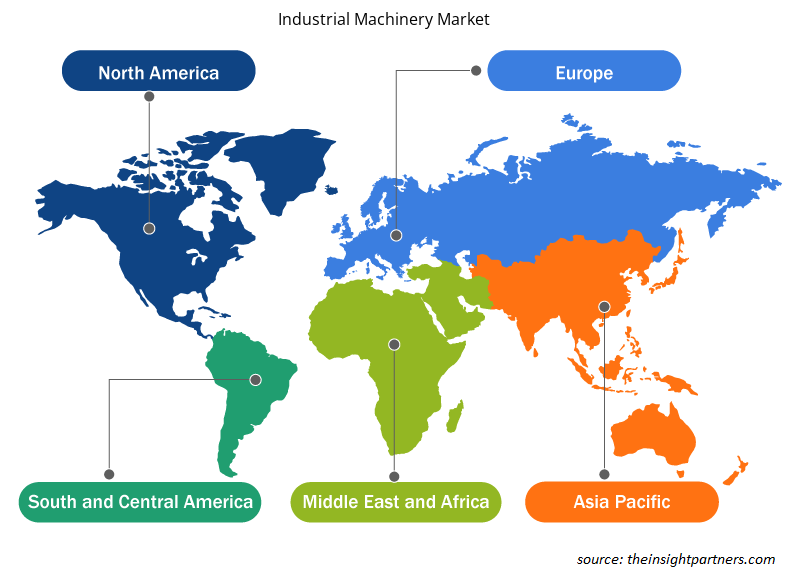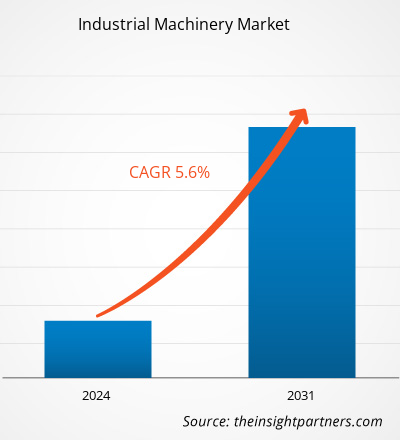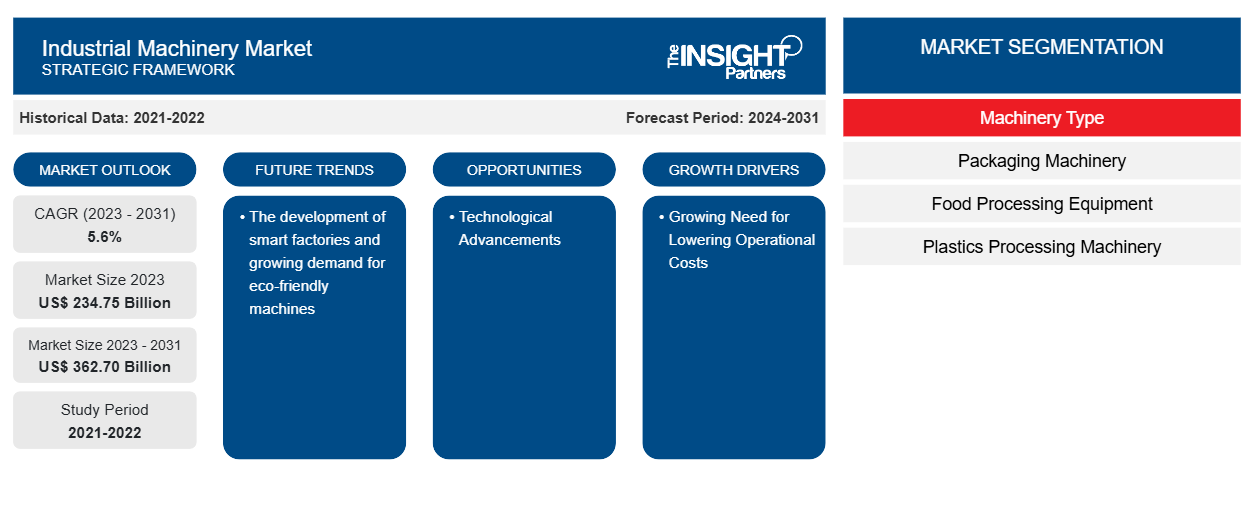工业机械市场规模预计将从 2023 年的 2347.5 亿美元增至 2031 年的 3627 亿美元。预计 2023-2031 年市场复合年增长率为 5.6%。智能工厂的发展和对环保机器的需求不断增长可能仍是工业机械市场的主要趋势。
工业机械市场分析
由于降低运营成本的需求不断增长,以及汽车、食品饮料、制药、制造业和其他行业越来越多地采用工业机械,工业机械市场正在快速增长。在城市化和工业自动化不断发展的推动下,市场正在稳步扩张。此外,技术进步以及人工智能和 3D 数字打印技术的融合为市场增长提供了丰厚的机会。
工业机械市场概况
工业机械是指任何设计和使用以执行特定功能并产生特定结果的机械、电气或电子设备。制造工厂的制造商使用这些机械进行切割、成型、成型、层压或协调生产过程。工业机械在支持全球工业活动方面发挥着至关重要的作用。日益发展的数字化、技术进步和工业 4.0 计划正在为市场创造机遇。
定制此报告以满足您的需求
您可以免费定制任何报告,包括本报告的部分内容、国家级分析、Excel 数据包,以及为初创企业和大学提供优惠和折扣
-
获取此报告的关键市场趋势。这个免费样品将包括数据分析,从市场趋势到估计和预测。
工业机械市场驱动因素和机遇
降低运营成本的需求不断增长,推动市场发展
较低的运营成本可带来较高的利润,使企业能够通过削减成本的举措来多样化其产品供应并进入新市场。企业对降低运营成本的需求日益增长,增加了对技术先进的机械的需求。制造商正在将物联网应用集成到这些设备中,以提供增强的服务,例如远程监控、中央反馈系统和其他功能。此外,制造商还采用增强型传感器、移动应用程序和嵌入式软件来简化其运营流程,从而降低总体业务成本,从而推动市场发展。
技术进步——工业机械市场的机遇
预计在预测期内,快速的技术进步将推动工业机械市场的创新。此外,制造业正在采用人工智能、3D 打印和大数据分析等先进技术来降低运营成本、提高生产率并获得更高的利润。然而,3D 打印和人工智能技术的潜在融合正在为工业机械市场的国内外参与者创造增长机会。
工业机械市场报告细分分析
有助于得出工业机械市场分析的关键部分是机械类型。
- 根据机械类型,工业机械市场分为包装机械、食品加工设备、塑料加工机械、金属成形机床、木工机械。
- 包装机械细分市场细分为灌装机、码垛机、贴标机、包装机等。食品加工设备细分市场细分为切片机和切块机、挤出设备、浇注机和搅拌机、存储和冷藏设备等。塑料加工机械细分市场细分为检测成型机、吹塑机、挤出成型机等。金属成型机床细分市场细分为压力机、折弯机、铸造机、冲压机等。木工机械细分市场细分为车床、磨床、带锯机等。
工业机械市场份额按地区分析
工业机械市场报告的地理范围主要分为五个地区:北美、亚太、欧洲、中东和非洲、南美/南美和中美。
从收入来看,由于交通、能源和城市发展等基础设施项目的投资不断增加,亚太地区占据了最大的工业机械市场份额。对各种工业设备(如建筑机械、土方设备和物料搬运设备)的需求不断增长,推动了该地区市场的发展。
工业机械市场区域洞察
Insight Partners 的分析师已详尽解释了预测期内影响工业机械市场的区域趋势和因素。本节还讨论了北美、欧洲、亚太地区、中东和非洲以及南美和中美洲的工业机械市场细分和地理位置。

- 获取工业机械市场的区域特定数据
工业机械市场报告范围
| 报告属性 | 细节 |
|---|---|
| 2023 年的市场规模 | 2347.5亿美元 |
| 2031 年市场规模 | 3627亿美元 |
| 全球复合年增长率(2023 - 2031)CAGR (2023 - 2031) | 5.6% |
| 史料 | 2021-2022 |
| 预测期 | 2024-2031 |
| 涵盖的领域 |
按机械类型
|
| 覆盖地区和国家 |
北美
|
| 市场领导者和主要公司简介 |
|
工业机械市场参与者密度:了解其对业务动态的影响
工业机械市场正在快速增长,这得益于终端用户需求的不断增长,而这些需求又源于消费者偏好的不断变化、技术进步以及对产品优势的认识不断提高等因素。随着需求的增加,企业正在扩大其产品范围,进行创新以满足消费者的需求,并利用新兴趋势,从而进一步推动市场增长。
市场参与者密度是指在特定市场或行业内运营的企业或公司的分布情况。它表明在给定市场空间中,相对于其规模或总市场价值,有多少竞争对手(市场参与者)存在。
在工业机械市场运营的主要公司有:
- 伊莱克斯
- 阿法拉伐
- 株式会社天田
- GEA 集团
- 海天国际
- 三菱重工业株式会社
免责声明:上面列出的公司没有按照任何特定顺序排列。

- 了解工业机械市场顶级关键参与者概况
工业机械市场新闻和最新发展
工业机械市场通过收集一手和二手研究后的定性和定量数据进行评估,其中包括重要的公司出版物、协会数据和数据库。以下是工业机械市场的发展和战略列表:
- 2022 年 11 月,英格索兰推出了用于工业用途的 135MAX 重型气锤。135MAX HD 气锤是新一代气锤,它以 119MAX 奠定的基础为基础,以可承受的成本提供令人难以置信的性能和动力——同时利用受传奇的英格索兰冲击扳手启发的微调羽毛扳机,以获得更高的精度和更好的效果。(来源:英格索兰,新闻稿,2022 年)
工业机械市场报告范围和交付成果
“工业机械市场规模和预测(2021-2031 年)”报告对以下领域进行了详细的市场分析:
- 范围内涵盖的所有主要细分市场的全球、区域和国家层面的市场规模和预测
- 市场动态,如驱动因素、限制因素和关键机遇
- 未来的主要趋势
- 详细的 PEST/波特五力分析和 SWOT 分析
- 全球和区域市场分析涵盖关键市场趋势、主要参与者、法规和最新市场发展
- 行业格局和竞争分析,涵盖市场集中度、热点图分析、知名参与者和最新发展
- 详细的公司简介
- 历史分析(2 年)、基准年、预测(7 年)及复合年增长率
- PEST和SWOT分析
- 市场规模、价值/数量 - 全球、区域、国家
- 行业和竞争格局
- Excel 数据集
近期报告
客户评价
购买理由
- 明智的决策
- 了解市场动态
- 竞争分析
- 客户洞察
- 市场预测
- 风险规避
- 战略规划
- 投资论证
- 识别新兴市场
- 优化营销策略
- 提升运营效率
- 顺应监管趋势























 获取免费样品 - 工业机械市场
获取免费样品 - 工业机械市场